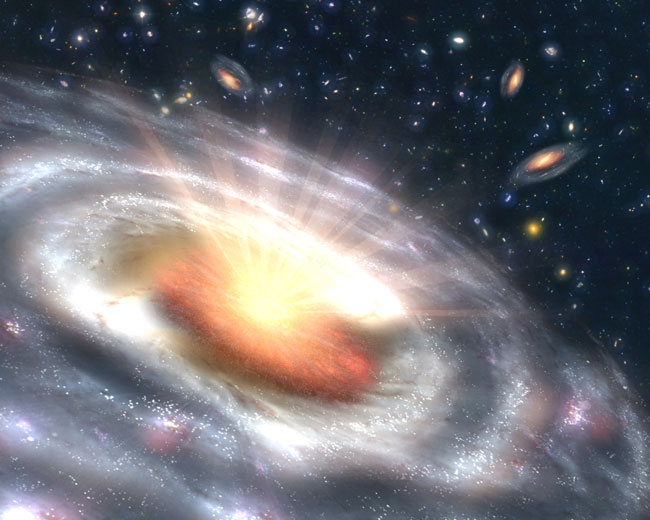Hundreds of 'Missing' Black Holes Found

Hundreds of "missing" black holes have been found lurking in dusty galaxies billions of light-years away.
"Active, supermassive black holes were everywhere in the early universe," said study team member Mark Dickinson of the National Optical Astronomy Observatory in Tuscon, Ariz. "We had seen the tip of the iceberg before in our search for these objects. Now, we can see the iceberg itself."
The finding, detailed in two studies published in the Nov. 10 issue of Astrophysical Journal, is the first direct evidence that most, if not all, massive galaxies in the distant universe spent their youths constructing supermassive black holes at their cores.
It could also help answer fundamental questions about how massive galaxies such as our Milky Way evolved.
"It's as if we were blindfolded studying the elephant before, and we weren't sure what kind of animal we had," said study team member David Elbaz of the Commissariat a l'Energie Atomique in France.
Using NASA's Chandra X-ray and Spitzer Space Telescopes, the team detected unusually high levels of infrared light emitted by 200 galaxies in the distant universe. They think the infrared light was created by material falling into "quasars"—supermassive black holes surrounded by doughnut-shaped clouds of gas and dust—at the center of the galaxies.
The new quasar-containing galaxies are all about the same mass as our Milky Way, but are irregular in shape. They are located 9 billion to 11 billion light-years away and existed at a time when the universe was in its adolescence and between 2.5 and 4.5 billion years old.
Get the Space.com Newsletter
Breaking space news, the latest updates on rocket launches, skywatching events and more!
For decades, scientists have predicted that a large population of quasars should be found at those distances but had only spotted a few of them.
The new finding brings observations closer to theory. "We found most of the population of hidden quasars in the early universe," said study leader Emanuele Daddi, also of the Commissariat a l'Energie Atomique.
The newfound quasars confirm what scientists have suspected for years now: that supermassive black holes play a major role in star formation in massive galaxies. The observations suggest massive galaxies steadily build up their stars and black holes simultaneously until they get too big and the black holes suppress star formation.
The new quasars also suggest that collisions between galaxies might not be as important for galaxy evolution as once thought. "Theorists thought mergers between galaxies were required to initiate this quasar activity, but now we see that quasars can be active in unharassed galaxies," said study team member David Alexander of Durham University in the UK.
- The Strangest Things in Space
- Video: Black Holes: Warping Time & Space
- Top 10 Star Mysteries
Join our Space Forums to keep talking space on the latest missions, night sky and more! And if you have a news tip, correction or comment, let us know at: community@space.com.

Space.com is the premier source of space exploration, innovation and astronomy news, chronicling (and celebrating) humanity's ongoing expansion across the final frontier. Originally founded in 1999, Space.com is, and always has been, the passion of writers and editors who are space fans and also trained journalists. Our current news team consists of Editor-in-Chief Tariq Malik; Editor Hanneke Weitering, Senior Space Writer Mike Wall; Senior Writer Meghan Bartels; Senior Writer Chelsea Gohd, Senior Writer Tereza Pultarova and Staff Writer Alexander Cox, focusing on e-commerce. Senior Producer Steve Spaleta oversees our space videos, with Diana Whitcroft as our Social Media Editor.









